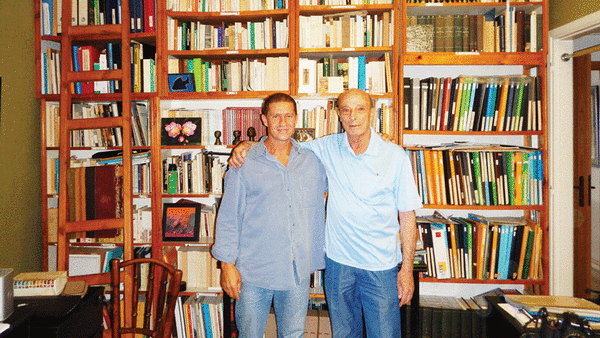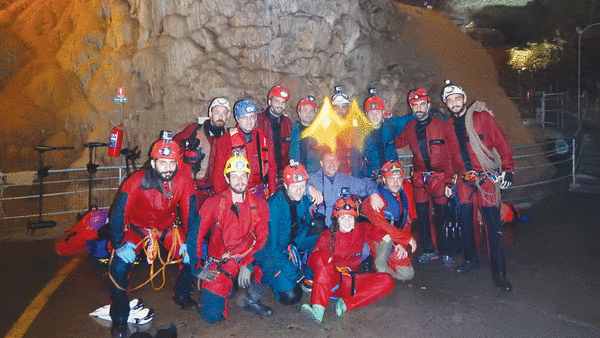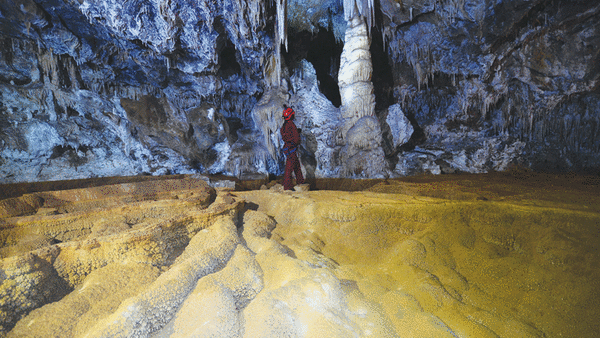

It was like an explosion of happiness and joy. We fell into each other’s arms and started jumping like kids.” With these words, 85-year-old Lebanese cave explorer Sami Karkabi recalled the reaction of his team when they first saw the upper galleries of Lebanon’s Jeita cave in the 1950s.
“It is the most beautiful show cave in the world. It is a wonder,” said Karkabi, co-founder of the Spéléo Club du Liban (SCL). Established in 1951, SCL is the oldest caving club in the Middle East. Karkabi was driven by curiosity when he decided to climb a 10-metre-high cornice in the cave, which led to the discovery of the upper galleries in 1958.
“We used a telescopic mast to reach that ledge and then the marvelous foundations of limestone stalagmites and stalactites started unfolding in front of our eyes. It took us two days to complete the visit of the whole upper gallery,” Karkabi said.
Jeita cave, a tourism landmark in Lebanon, was a candidate in 2011 to become one of the seven natural wonders of the world. From a list of 440 sites in 220 countries, the Lebanese wonder reached the final stage with 13 other contenders but wasn’t selected for the list.

Signs of the existence of the cave, which has two galleries, including a lower one that follows the course of an underground river, were reported in 1836 by an American, Reverend William Thomson, who ventured some 50 meters into the cave, stopping at the edge of the water.
Some 40 years later, American W.J. Maxwell, ventured deeper into the cave, following the river stream about 1,060 metres into the mountain.
Many other expeditions were undertaken by Americans, British and French cavers( they reached 1500m), in addition to Lebanese explorers, including Karkabi, who ventured as far as 6,400 metres into the lower gallery, which is commonly referred to as the “water gallery”.
Karkabi recalled how he pushed further the exploration of the “water gallery” after fellow cavers, Li- onel Ghorra and Albert Anavy, were discouraged by a 15 metres cliff at 2,800 metres deep.
“In 1949 Ghorra and Anavy reached a spectacular room, which they baptised as the ‘Dome Room’ but they hit a cliff, which they estimated to be probably 40 metres high and thought it was off the limit of the Lebanese team capacities,” he said.
“Pushed by my curiosity, I imported a special telescopic mast with a ladder from France and managed with my team to climb that obstacle, which turned out to be only 12 metres high,” Karkabi said. His exploit opened the way for cavers to progress into the grotto and reach the “terminal sump” at 6,400 metres from the entrance in 1954.
Karkabi recalls the risks and difficulties cavers faced at the time, “Our equipment was rudimentary, as we had no wetsuits to protect us from the cold and we were using “Lux” for the light , instead of headlights,” he said.
“It took us many days to do the mapping of the cavern. It happened that in one instance, we had to stay underground for more than one week in a row without seeing daylight,” he said, boasting that they “never had a single accident”.
SCL was entrusted to transform Jeita into a show cave. The work, involving the construction of alleyways and bridges in the upper gallery, started in 1967 under the supervision of artist and sculptor architect Ghassan Klink. The cave was opened to the public in 1969 with a concert given by the famous composer François Bayle.
“To protect the calcite formations from dust during the work we had to cover them with plastic sheath- ing,” Karkabi said. “Stalactites, stalagmites and other marvellous shapes take thousands of years to develop and grow; breaking one or polluting it could lead to its death.”

For Karkabi the showcasing of Jeita is unfinished. Visitors have access to only 200 metres of the more than 6-kilometre-deep “water gallery”. “It’s a shame not to share more from this extraordinary artwork of nature with the public,” he said, noting that “visitors should be able to reach 2,000 metres had the work been done by the government”.
Lebanon is widely known for its richness in caves, which are usually caused by the wide coverage of carbonate rocks of the country’s surface area, fracturing and faulting due to tectonic activities and the high rate of precipitation. Rainwater attacks carbonate rock, dissolving it along fractures and faults, forming caves.
Joey Abou Jawdeh, a young architect and member of the club, acknowledged SCL’s decreasing activities, pointing out that the club has more than 100 members but only 30 are active.
Nonetheless, Abou Jawdeh said, the club is credited for the discovery of several caves and 60 new sinkholes with depths of 15-60 metres in the area of Jaij in Mount Lebanon. “In Lebanon, we have more than 700 caves and sink holes listed, many of which are unexplored,” he said. Caving in Lebanon has become a popular sport in the last decade. Trips into caves range from simple touristic activities to complicated extreme sports.
I had the chance to know Georges Farra and Sami Karkabi , who was the first to climb in the upper gallery of Jeita Grotto. I used to visit Sami every time I travelled to Lebanon and since he passed away around 6 years ago, I started connecting with Georges and we became very close friends.

Georges is an 85-year-old retired pilot of Lebanon’s flag carrier, the Middle East Airlines. He was a very active member of the Speleo Club du Liban and was part of all the expeditions of the club. Every time I visit him and his wife, Therese, I spend hours listening to his exciting stories about their expeditions. I would live his stories because Georges tells them with so much passion.
I visited him last week with a very good friend Johnny Tawk, the current president of the club and again Georges fascinated us with some of his “old “stories .
Touristic caves such as Jeita and Qadisha offer a walk through beautiful scenery. But adventure lovers, who are driven by the exhilaration of facing the unknown, can venture with SCL teams into caves that are not equipped for touristic purposes but are sites for ecotourism. Those sites include Roueiss, Nabaa el Qana and Mgharet Nabaa el Mghara in the northern part of Mount Lebanon.
Definitely, Lebanon has many wonders in its belly waiting to be discovered.
Oman Observer is now on the WhatsApp channel. Click here










